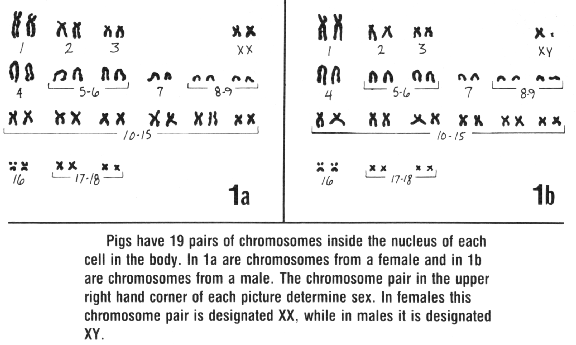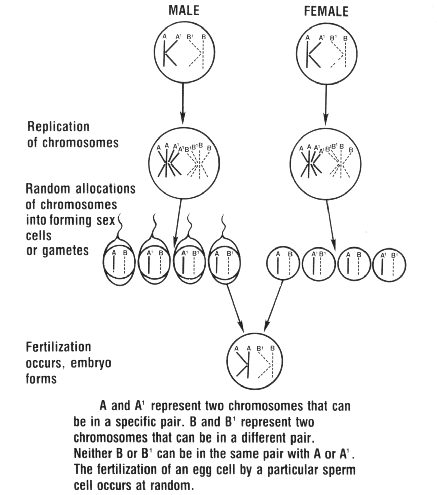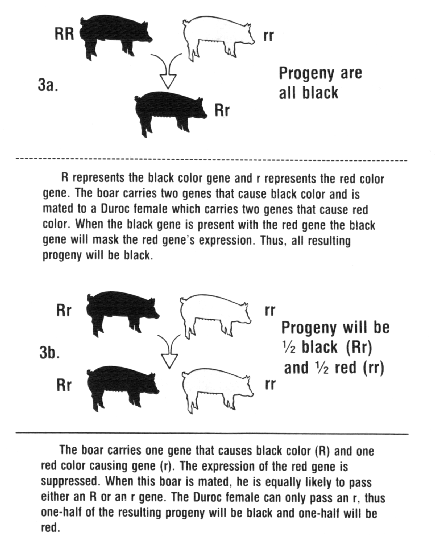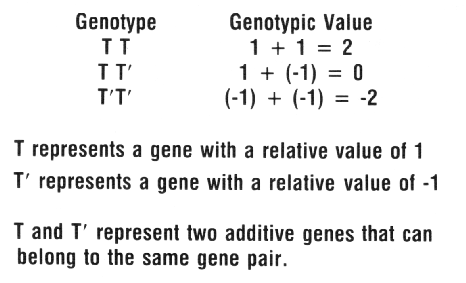
NSIF-FS2

M. Peter Hoffman, Iowa State University
Larry D. Young, U.S Meat Animal Research Center, USDA/ARS, Clay Center, Nebraska
Charles J. Christians, University of Minnesota.
The swine industry is re-emphasizing the importance of efficiently developing a quality product. To fulfill this objective, market hogs will need to come from larger litters and convert feed into lean meat more efficiently. For this to occur in your herd, favorable genetic change needs to be made in those traits that effect efficiency of production. Therefore, pork producers need to understand basic genetic concepts so that they can apply them to improve economically important traits.
Genetics is a science that studies heredity and variation. Heredity is defined as the resemblance among individuals related by descent, and variation is the occurrence of differences among individuals of the same species. Therefore, genetics is the science of the study of resemblances and differences that exist among individuals.
Genes, which are comprised of DNA (deoxyribonucleic acid), are the basic unit of inheritance. Resemblances and differences among related individuals are primarily due to genes. Genes cause the production of enzymes which in turn control chemical reactions in the body, thus affecting body development and function. For normal body development and function, genes must occur in pairs. Genes are a part of the chromosomes that reside in the nucleus of body cells. Chromosomes in the nucleus of a particular cell contain the same genetic information as the chromosomes in every cell of the body. Therefore the chromosomes in the cells of a pig's tail are exact copies of the chromosomes in the pig's heart; however, the genes on the chromosomes know their function in specific body tissues.
In the normal cell of a pig, or any mammal, chromosomes occur in distinct pairs. Pigs have 19 chromosome pairs for a total of 38 chromosomes (Figure 1). This contrasts with humans, who have 23 chromosome pairs for a total of 46. Since chromosomes occur in pairs, genes also exist in pairs. If there are more or less than two chromosomes in a pair, an abnormality will occur. A classic example of this is Down's Syndrome in humans. Persons afflicted with Down's Syndrome often have three members in a particular pair of chromosomes instead of the normal two. Not all genetic abnormalities are caused by extra members in a chromosome group. Genetic abnormalities are also caused by deleterious or detrimental genes.

Gamete Formation and Fertilization
Chromosomes and gene numbers change during gamete or sex cell formation. These gametes are the eggs produced by sexually mature gilts or sows and the sperm cells produced by sexually mature boars. During gamete formation, the chromosome pairs of a cell duplicate, and then one of the four members that are associated with the duplicated chromosome pairs is randomly transferred to one of four forming sex cells or gametes (Figure 2). The newly formed gamete now contains only one member of each chromosome pair. This splitting of chromosome pairs causes a random transfer of each member into a forming gamete.
When the egg and the sperm unite at fertilization, each carries only one member of each original chromosome pair. The joining of a particular egg and sperm cell occurs at random. After fertilization, the new cell, which develops into the fetus, will have one member per chromosome pair from its sire and the other member from its dam. Thus, the chromosome number is restored to its original value (Figure 2). The resulting offspring will be genetically different from either parent because of the union of randomly matched gametes. Since pigs have 19 chromosome pairs, there are 524,288 (2 to the 19th power) different chromosomal arrangements that can occur during gamete development. With many different genes on each chromosome, the possible number of distinct assortments of genes in forming gametes is infinite. Therefore, the possible number of genetically different pigs can be much larger than the total number of pigs being raised on the nation's farms.

Random Segregation And Genetic Variation
The random transfer of chromosomes and their genes to forming gametes is called random segregation. Random segregation is a major cause of genetic differences among related individuals. Differences in genetic makeup are often referred to as genetic variation. Traits showing a large amount of genetic variation have a better chance of responding to selection. If a large amount of genetic variation is present in a population, some animals will carry many favorable genes while others will have more undesirable genes for a given trait. If individuals with favorable genes can be identified, there is an increased likelihood that those individuals will pass those favorable genes on to their offspring. The specific genes that reside in the gene pairs that control a trait is called the animal's genotype.
For a given gene pair, the two genes can be alike or different. A homozygous gene pair has two identical genes while a heterozygous gene pair has different genes. Gene action can be grouped into two categories, nonadditive and additive.
When nonadditive gene pairs control a trait, the members of the gene pairs will not be equally expressed. For example, the red-black color condition in pigs is controlled by one gene pair that has nonadditive gene action. If a black boar with two black genes is mated to a Duroc sow with two red genes, the offspring will all be black (Figure 3a). This is because the black gene which is passed to the offspring from the boar will mask the expression of the red gene that is passed from the sow. The black gene is said to be dominant to the red gene since it will not allow expression of the red gene. If the black boar had one black and one red color causing gene (Figure 3b) then the situation would be different. On the average, half of the boar's offspring would receive his black gene, while the other half of the offspring would receive his red gene. If this heterozygous black boar is mated to Duroc females, half of the offspring would be expected to be black while the other half would be red. The red gene is said to be recessive to the black gene. Red pigs will occur only when two red genes are in the gene pair controlling red-black color in pigs. The visual characteristic of a trait that can be seen (such as red or black color) or measured (e.g., growth or backfat) is called an animal's phenotype.


Additive genes are those in which members of a gene pair have equal ability to be expressed. Thus the expression of the gene pair is the sum of the individual effects of the genes in the pair. In Figure 4, T represents a gene that has a relative value of 1 while T' represents a gene which has a relative value of -1. An individual with a TT' genotype would have a genotypic value of 0 (1+(-1)). When a trait is controlled by additive genes, its expression is based on the sum of the effects of the individual genes.
All traits of swine are not controlled by just one gene pair. In fact, very few economically important traits are controlled by a single or few gene pairs. Traits such as age at 230 pounds, litter size, and average backfat thickness are controlled by possibly hundreds of gene pairs.
Consequently, traits are generally grouped into two categories, qualitative and quantitative.
Qualitative traits have four distinguishing characteristics. These are:
Quantitative traits are dissimilar in their attributes when compared to qualitative traits. Characteristics of quantitative traits include:
1. Quantitative traits are controlled by possibly hundreds or thousands of gene pairs located on several different chromosome pairs. Some gene pairs will contain additive genes while others can contain nonadditive genes. Most economically important traits are quantitative traits.
2. The environment does affect expression of the gene pairs controlling quantitative traits. If two pigs are similar genetically, with one raised in a confinement unit and the other raised in a dirt lot, their growth performance will probably be different.
3. Phenotypes of quantitative traits cannot be classified into distinct categories since they will usually follow a continuous distribution. An example would be average daily gain. If average daily gain records from weaning to market weight of every pig in a group, were plotted the points would form a continuous line. An exception of this are some of the reproductive traits. For example, litter size is a quantitative trait but can be grouped into distinct groups of 7, 8, etc. It is impossible to accurately determine how many gene pairs are controlling a quantitative trait; therefore, an exact gene type can never be determined.
These factors make it difficult to identify individuals that have superior genotypes for quantitative traits.
With all traits, the individual's phenotype is the sum of effects of the genotypic and the environmental effects (phenotype = genotype + environmental effects). Since qualitative traits are usually not affected by the environment, the phenotype of a qualitative trait is a good indicator of the genotype. Environmental effects do influence the phenotypic expression of a quantitative trait. An individual with an inferior genotype can rank higher phenotypically than individuals with superior genotypes because of favorable environmental effects. thus it is important to treat all animals the same to reduce environmental effects. Usually an individual's phenotype, compared to the herd average, is a good indicator or estimate of his genotype, or genotypic value.
Since a boar passes one-half of his chromosomes, and thus one member of each gene pair, to his offspring, he also passes on one-half of his genotypic value to his offspring. An individual's genotypic value is often called his breeding value (BV). The estimate of an individual's genotypic value is his estimated breeding value (EBV). Ranking individuals by their EBV's for specific traits is a means of identifying individuals that are expected to have superior genotypes.
Genetic evaluation programs often estimate the transmitting ability of an individual. The estimated transmitting ability is equal to one-half of an individual's estimated breeding value. The estimate of transmitting ability is the contribution that a sire or dam is expected to make to the genotypic value of their offspring. The Swine Testing and Genetic Evaluation System refers to it as Expected Progeny Difference (EPD).
Swine producers who thoroughly understand genetic principles and utilize improved genetic evaluation techniques will be able to improve production efficiency and lower their production cost. This will allow them to stay competitive in today's changing swine industry.
RR 8/94
Cooperative Extension work in Agriculture and Home Economics, State of Indiana, Purdue University and U.S. Department of Agriculture cooperating: H.A. Wadsworth, Director, West Lafayette, IN. Issued in furtherance of the acts of May 8 and June 30, 1914. The Cooperative Extension Service of Purdue University is an equal opportunity/equal access institution.